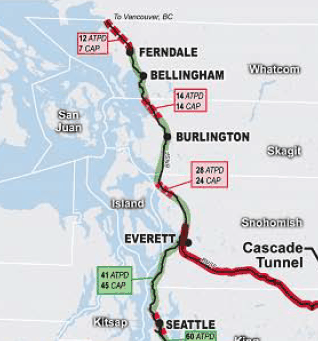Washington’s rail system is congested in places. Adding dozens of coal trains each day, without also big new capacity improvements, could cripple the system with gridlock. All that is common knowledge. Less well-known is this: coal shipments are already causing problems.
To understand what’s going on, it’s useful to zero in on the northwest portion of the state’s railway system. Here’s a close look at northwest Washington, the area most directly affected by Cherry Point coal exports:
This Cambridge Systematics map from 2006 is the most recent comprehensive analysis of the state’s rail system. The green on the mainline between Everett and Canada indicates adequate capacity, but the numerous red dots indicate hotspots of local congestion that plague the system.
What’s happening on the ground there now? In May 2011, the regional rail experts at the Cascadia Center produced the “Cross-Border Freight Rail Improvement Study,” for the Whatcom Council of Governments (along with a companion volume “Cross-Border Passenger Rail Improvement Study). It turns out that things in the area are not going smoothly.
There are a variety of reasons, but one reason is coal.




